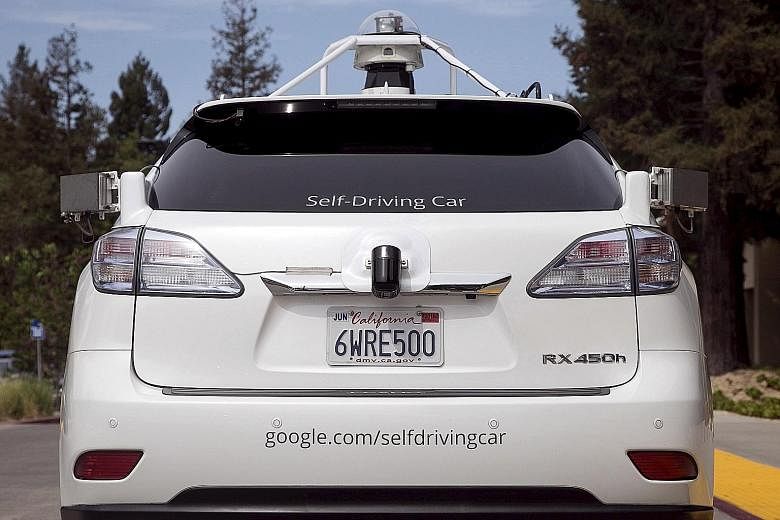AUSTIN, TEXAS • The Alamo Drafthouse Cinema Plaza here is a strip mall with a pet accessories store, a Thai restaurant and a yogurt shop, an unlikely venue to display the high-tech future. But one Saturday morning last month, Google did just that.
A small convoy of its driverless cars cruised into the fading asphalt parking lot to give test drives - test rides, actually - to American mayors visiting Austin's annual South by Southwest tech-and- culture festival.
Mayor Richard Berry of Albuquerque, New Mexico, was impressed with how the cars dodged pedestrians and fallen tree limbs. Mr Sam Liccardo, mayor of San Jose, California, right in Google's backyard, was impressed that he got to see the cars at all.
"These things are crawling all over my city" in tests, "but I had to come to Austin to ride in one", said Mr Liccardo. "This is going to change cities."
But before that happens, Google needs to change regulations - the federal, state and local edicts that cover everything from whether cars must have steering wheels to who is at fault if a driverless car hits another vehicle.
And so behind the technology display here was something as formidable as the technology but far less noticed: Google is mounting a lobbying and public relations campaign across the United States to win acceptance for "autonomous vehicles", as they are formally known, and to shape the rules of the driverless road.
Last year, Google made Austin the first site outside Silicon Valley to test its driverless cars on public streets. This year, it has added Kirkland, Washington, and Phoenix, Arizona. The proliferation of cities is aimed at gaining public acceptance for driverless cars, Google executives acknowledge, in addition to testing them in different driving conditions.
The test cars all have company- trained drivers and none yet offer rides to the public. But in each city, Google does "public outreach", in its words, such as town-hall meetings to explain the technology and tout its safety.
Self-driving technology has developed far faster than experts envisioned when Google started developing it in 2009. Cars with partial autonomy, such as Tesla's Model S, are on the road now and limited trials of fully self-driving vehicles are popping up. They could appear in urban transit systems within a few years, though the transition in the broad consumer market could take far longer.
"I've gone from hoping this would happen to thinking it might happen to knowing it will happen," said Mr Chris Urmson, the 39-year-old director of Google's driverless-car programme.
Other companies, ranging from global car giants to Silicon Valley start-ups, also are developing driverless cars. And they, too, are lobbying state and federal regulators in an effort to massage the rules to their liking.
But Google, one of the first companies to launch a development effort, has emerged as the most visible and assertive lobbyist, with the most ambitious view of how self-driving vehicles should be deployed.
Scorning the gradualist approach, Google is pushing for fully autonomous vehicles. It won an important early victory in February when the National Highway Traffic Safety Administration ruled that the artificial intelligence system piloting a self-driving car could be considered the driver under federal law. That paves the way for regulators to make subsequent rulings that autonomous vehicles do not need steering wheels, brake pedals, accelerator pedals or other things that humans use to control motor vehicles.
On Tuesday, Google and four allies - Ford, Lyft, Uber and Volvo Cars - said they were forming "the Self-Driving Coalition for Safer Streets". The group will push for "one clear set of federal standards" for autonomous vehicles and try to build support for the technology among businesses and local governments.
The coalition's public face will be Mr David Strickland, the former head of the National Highway Traffic Safety Administration. The agency has promised to issue driverless-car guidelines by July. It is holding a public meeting next Wednesday at Stanford University in California to gather public input.
"The mission I have is we've got a clock ticking," said Transportation Secretary Anthony Foxx, who oversees the agency. "This technology is coming. Ready or not, it's coming."
But in California, Google's home state, officials want all autonomous vehicles to have steering wheels, brake pedals and accelerator pedals - which amounts to ensuring that driverless cars can have drivers. California's regulators believe there is no substitute, at least not for some years, for autonomous vehicles to be designed with a "handoff" system that allows a driver to retake control in an emergency.
Google maintains that requiring human controls makes driverless cars useless for elderly, blind and disabled people who cannot operate a vehicle and even makes the cars dangerous.
"Developing a car that can shoulder the entire burden of driving is crucial to safety," Google's Mr Urmson told a US senate panel last month. "Human drivers can't always be trusted to dip in and out of the task of driving when the car is encouraging them to sit back and relax."
REUTERS

